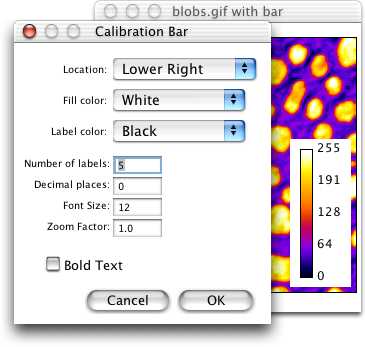
You should always make a duplicate of you image and add the scale bar to that, so you don't destroy the original image when you save it. Note: in ImageJ addind a scale bar burns that scale bar into the image, so it should be the very last thing you do to the image before presenting it. Inform=$(whiptail – inputbox "Here you may additional infromation" – backtitle "Press Esc to end script" 8 78 $INIT – title "Additional information" 3>&1 1>&2 2>&3)Įcho "You added "$inform" as additional information to the strip at the bottom.This page shows you how to add a scale bar to images in ImageJ You may also use hex colour codes" – backtitle "Press Esc to end script" 8 78 $INIT – title "Background colour" 3>&1 1>&2 2>&3)Įcho "You selected "$bgcolour" as background colour."

You may also use hex colour codes" – backtitle "Press Esc to end script" 8 78 $INIT – title "Colour" 3>&1 1>&2 2>&3)Įcho "You selected "$colour" as scale bar."īgcolour=$(whiptail – inputbox "Specify the background colour. If (whiptail – title "Scale bars for micrographs" – backtitle "Press Esc to end script" – yesno – yes-button yes – no-button no "Would you like to use the default scale bar colour scheme?" 10 40 )Įcho "Your selection: white scale bar on black background"Įxt=$(whiptail – inputbox "Specify the file extension (jpg, jpeg, png, tif.)" – backtitle "Press Esc to end script" 8 78 $INIT – title "File extension" 3>&1 1>&2 2>&3)Įcho "You selected "$ext" as file extension."Ĭolour=$(whiptail – inputbox "Specify the scale bar colour. # whiptail is used for a simple menu structure # The first line creates a folder called annotated within the selected directory # Use a simple shell loop, to process each of the images. #the new image is saved in a new folder called "annotated" # the scalebar is put into a small strip at the bottom of the image # the section length is used to calculate the scalebar # This simple script reads the meta information of a a file, specifically the EXIF keywords, and extracts the section length. I am using EXIF, XMP and IPTC meta data formats, which can easily be added, edited and deleted with digiKam. To this end I use meta data that can be embedded into the digital image.ĭigiKam offers a large range of professional solutions, is under constant development and is an excellent editor for meta data.Īll that is required for the script to work is that the width of the field of view of the image is stored within the meta data keywords. The script is based on the idea to store all relevant information within the image itself. Thanks to the help with regular expressions of Johannes Kutterer from I finally sat down and wrote a shell script that does the annotating by itself. Annotating micrographs using meta tags and a simple shell script Specify length, colour and placement of the scale barģ. Enter details, such as the known image width in µm and in pixelģ. You may use the programme ImageJ to speed up things quite a bit, but it still rerquires a manual work.ġ. Making scale bars – Using Scientific Image manipulation software ImageJ If you do one or two mircographs this approach is fine, but if you have to annoate tens or hundreds of micrographs with scale bars, this becomes rather tedious. Of course you may also draw a proper scale bar in Inkscape and scale to the dimensions you require. In GIMP open micrograph import scale bar and place it.Set bitmap size in accordace with your calculated scale bar. Make sure to use the selection button (here: called Auswahl). Take a micrograph of a stage micrometer for every objective lens you intend to use.Is is any good to note the magnification in your records? The answer is no, because the magnification relates to the image you see through your ocular lenses. Annotating micrographs using meta tags and a simple shell script 1. Making scale bars – Using Scientific Image manipulation software ImageJģ.


The left image (click!) informs us about the image in an unobtrusive bar at the bottom of the image, the right image shows the solution with the scale bar.Ģ. There are two ways possible: Either use the caption to tell us the image width, or annotate the image with a scale bar. Any meaningful micrograph needs a scale as a means of informing us about the size of the documented microscopic structutres. This post describes three of the many possible ways of annotating micrographs with a scale bar: manually, semi-manually and fully automated.


 0 kommentar(er)
0 kommentar(er)
